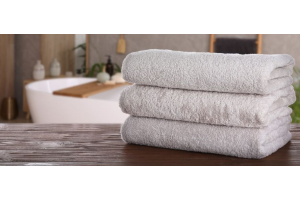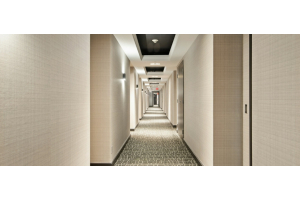We use cookies to give you the best possible experience. To accept cookies continue browsing, or view our Cookies Policy to find out more.
What Are The Benefits Of Anti-Allergy Bedding?

Millions of people around the world suffer from allergies. But did you know that your bedding could be the culprit that’s triggering your allergies? Bedding can end up exacerbating conditions such as asthma and eczema, particularly if it’s not been washed for a while.
Ensuring you wash your bedding regularly will go a long way to eliminating the triggers that cause allergies, but there is another form of defence that you should think about: anti-allergy bedding.
What is anti-allergy bedding?
When we label our bedding anti-allergy, we largely mean that it will help protect you against dust mites (however, they can also reduce the growth of mould spores and protect against things such as pet dander). These pesky little critters love to make a home in the high-humidity of your nice warm bed. They live off your dead skin, which your bed is obviously going to be full of. The average bed can hold as many as 10 million dust mites! But you’ll never even know, as dust mites are around 0.25-0.3 millimetres in size.
Anti-allergy bedding works by either using anti-dust mite coatings or the filling of the pillow or duvet being more tightly woven to ensure that dust mites can’t break through. It has the added benefit of limiting other organic matter from being deposited in the fibres of your bedding too.
It doesn’t matter what type of bedding filling you have either, as dust mites love synthetic and natural fill easily. It’s a myth that natural filled bedding is more likely to make your allergies worse, unless you have an allergy to feathers (although products such as pillow protectors can lower the risk). It’s actually synthetics that have a higher chance of harbouring dust mites, as synthetic material is less breathable than natural material.
Aside from pillows and bedding, anti-allergy mattres protectors to protect your mattress and anti-allergy pillow protectors for your pillows (especially if they're not anti-allergy pillows) are both good ideas.
What’s the difference between anti-allergy, non-allergenic, and hypoallergenic?
Once you’re on the search for your perfect bedding, you’re probably going to hear a few different terms that might confuse you. These terms are anti-allergy, non-allergenic, and hypoallergenic. While, on the face of it, they all serve to help reduce allergies, there are some slight differences that you need to know about.
Non-allergenic: This means that the product won’t cause an allergic reaction, but triggers such as dust mites may still be present.
Hypoallergenic: This means that there is a decreased chance of an allergic reaction. Organic cotton is naturally hypoallergenic and is more breathable, which reduces moisture and the damp conditions that dust mites love.
Anti-allergy: This means that an active ingredient or the product makeup is intended to prevent or minimise an allergic reaction and helps reduce the presence of dust mites.
What else can I do to prevent dust mites in my bedding?
As we’ve already mentioned, just make sure to wash your bedding regularly. That includes pillows and duvets, provided they are machine washable.
When you do wash your bedding, wash it at 60° or above to help kill off the dust mites (remember to always follow the instructions on the washing label).
Dust mites can eventually build up with age, so we recommend replacing your pillows every one to two years and duvets every 5 years, with a mattress needing replacing after 10 years. But it’s worth checking on the condition of both at least once a year, just to make sure they’re still in a healthy condition.
How can I prevent dust mites and other allergens building up within my bedroom?
Away from the bedding, there are a few other things you can do to prevent dust mite build-up.
- Vacuum carpets regularly. You could even go one step further and remove carpets altogether, as dust mites won't be able to grow on a hard floor surface such as wood
- Regularly wash any soft toys or cushions that sit on the bed
- When dusting the bedroom, use a damp cloth to pick up the dust to avoid simply moving the dust around
- Give the bedding some time to air every morning by not making it straight away. Instead, pull back the covers to allow overnight moisture to escape
- Consider purchasing an air purifier, as these draw common impurities such as allergens like dust, pollen, and pet hair from the air
- Try to keep pets out of your bedroom and especially off the bed
- During high pollen season, keep windows in your bedrooms closed (if you want a window open, at least purchase an air purifier). You can check the pollen count in your area through weather websites and apps
- Keep the humidity in your home below 50%, and always run an extractor fan when having a bath or shower in your bathroom (not doing so doesn't just affect the bathroom, it can affect the rest of your home too)
How can Vision Linens help you with anti-allergy bedding?
Here are Vision Linens we have a range of anti-allergy or non-allergenic bedding amongst our pillow and duvet collections. Just use the provided ‘refine by’ filter, expand the features section and click ‘anti-allergy’ to only show those produces that feature it.
Alternatively, click here for anti-allergy and non-allergenic pillows. Click here for anti-allergy and non-allegenic duvets. Finally, we also have some anti-allergy mattress protectors and anti-allergy pillow protectors.
You may also want to take a look at our More Than Clean range. This range includes Micro-Fresh protection, which is applied during the manufacturing process and is hypoallergenic.
Read our article on antibacterial protection for more information about More Than Clean.
Ultimately, anti-allergy or anti-dust mite bedding is important as it helps eliminate dust mites and reduces the risks of your allergies flaring up.







